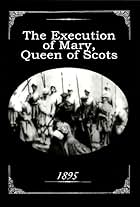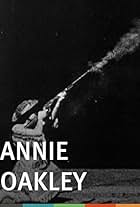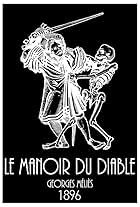Le squelette joyeux
- 1898
- 1m
IMDb RATING
6.4/10
1.2K
YOUR RATING
A skeleton dances joyously, often collapsing into a heap of bones and quickly putting itself back together.A skeleton dances joyously, often collapsing into a heap of bones and quickly putting itself back together.A skeleton dances joyously, often collapsing into a heap of bones and quickly putting itself back together.
- Director
Storyline
Did you know
- TriviaThe film is also known as "The Dancing Skeleton".
- ConnectionsEdited into The Lumière Brothers' First Films (1996)
Featured review
A common misconception is that motion pictures give the illusion of life; to the contrary, its illusion is one of death. Indeed, André Bazin, in "The Ontology of the Photographic Image," theorized cinema as mummification, a practice of embalming the dead. In traditional live-action cinema, life and motion is captured, made dead and still series of photographs, before being reanimated and projected on a screen like some grotesque Frankenstein monster--or a dancing skeleton. Lumière wasn't the first to realize this, either. For centuries before the Cinématographe was invented, there was the screen practice of the magic lantern, or "the lantern of fear," as it was otherwise known. Perhaps, the first such lantern slide, as illustrated by Christiaan Huygens in 1659, was of a skeleton given the illusion of macabre movement (see Laurent Mannoni's "The Great Art of Light and Shadow: Archaeology of the Cinema"). Later, a band of sequential images was given the illusion of motion by rapid succession via intermittent movement in Beale's Choreutoscope; the most famous of these are six images of a dancing skeleton (reprinted in Brian Coe's "The History of Movie Photography" and elsewhere). There was also Robertson's Phantasmagoria, which employed back-projected lantern slides moving on tracks to frighten spectators with approaching skeletons and other jump scares. It's appropriate, then, too, that when Disney further or re-popularized hand-drawn animation that the studio's first "Silly Symphony" should've been "The Skeleton Dance" (1929).
As for this Lumière film of the supposedly "cheerful" or "merry" "Dancing Skeleton," its also been misattributed as an early example of stop-motion animation, although I think it's rather obvious that it's a marionette (and it's labeled as such in the Lumière catalogue (398, vue no. 831)) worked by an unseen operator, which aptly was also the case with the Cinématographe. It's also something of a puzzle as to why such puppetry is ever classified as animation like the hand-drawn or even stop-motion sort. It's live-action cinematography of an inanimate, dead object animated in real time for the view of the camera--not still drawings or images brought to life only during projection. In that sense, this is akin to the actualities that make up most of the Lumière catalogue and is what distinguishes this "Dancing Skeleton" from some magic lantern precedents or the Disney cartoon. Unlike those from Huygens, Beale, Robertson and Disney, this skeleton once "lived" and danced before the Lumière Cinématographe captured and killed it, only for it, long after everyone involved in making it has since died and for more than a century since it was made, turned into a cinematographic ghost, continually reanimated, broken apart and put back together again and made to dance.
P.S. There's a third mistake that's been made across our present-day internet landscape regarding this film. There seems to have been two "Dancing Skeleton" films made in 1897 or 1898 (the Lumière film is listed as being programmed for a 20 March 1898 screening, but may've been photographed, if not released, earlier), one by Lumière and the other by the American Mutoscope Company, which the AFI catalog gives a release date of November 1897. Besides it or the Lumière film being cannibalized for AM&B's multiple-exposure trick film, "Davy Jones' Locker" (1900), the American Mutoscope film seems to be lost despite what some YouTube or Letterboxd posts might otherwise imply.
As for this Lumière film of the supposedly "cheerful" or "merry" "Dancing Skeleton," its also been misattributed as an early example of stop-motion animation, although I think it's rather obvious that it's a marionette (and it's labeled as such in the Lumière catalogue (398, vue no. 831)) worked by an unseen operator, which aptly was also the case with the Cinématographe. It's also something of a puzzle as to why such puppetry is ever classified as animation like the hand-drawn or even stop-motion sort. It's live-action cinematography of an inanimate, dead object animated in real time for the view of the camera--not still drawings or images brought to life only during projection. In that sense, this is akin to the actualities that make up most of the Lumière catalogue and is what distinguishes this "Dancing Skeleton" from some magic lantern precedents or the Disney cartoon. Unlike those from Huygens, Beale, Robertson and Disney, this skeleton once "lived" and danced before the Lumière Cinématographe captured and killed it, only for it, long after everyone involved in making it has since died and for more than a century since it was made, turned into a cinematographic ghost, continually reanimated, broken apart and put back together again and made to dance.
P.S. There's a third mistake that's been made across our present-day internet landscape regarding this film. There seems to have been two "Dancing Skeleton" films made in 1897 or 1898 (the Lumière film is listed as being programmed for a 20 March 1898 screening, but may've been photographed, if not released, earlier), one by Lumière and the other by the American Mutoscope Company, which the AFI catalog gives a release date of November 1897. Besides it or the Lumière film being cannibalized for AM&B's multiple-exposure trick film, "Davy Jones' Locker" (1900), the American Mutoscope film seems to be lost despite what some YouTube or Letterboxd posts might otherwise imply.
- Cineanalyst
- Nov 12, 2020
- Permalink
Details
- Release date
- Country of origin
- Language
- Also known as
- The Dancing Skeleton
- Production company
- See more company credits at IMDbPro
- Runtime1 minute
- Color
- Sound mix
Contribute to this page
Suggest an edit or add missing content




















